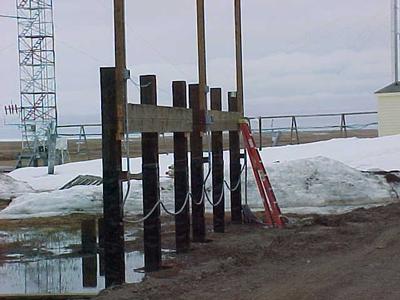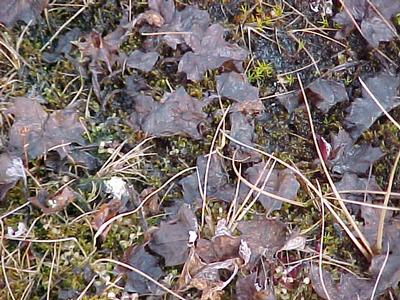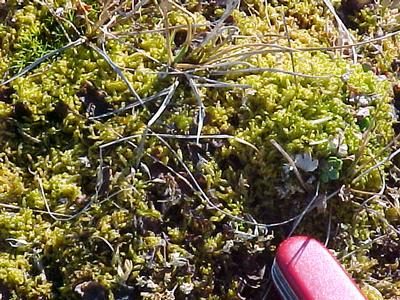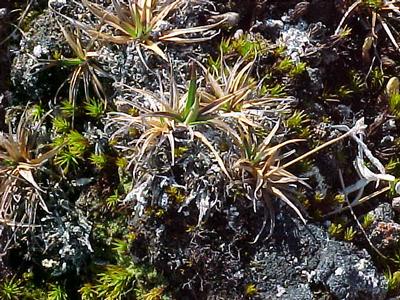17 June, 2001
Sunday
Plant day on the tundra.
Erika and I went out with Bob Hollister this AM to learn and practice
plant identification. Bob, from U. of Michigan, is completing his PhD
thesis with data gathered here at various sites around Barrow for the past
few years. He is extremely knowledgeable about the tundra's vegetation
and helped us out with names and characteristics.
The tundra ecosystem is characterized by short, fast growing, cold
tolerant plants, which survive on a limited water supply. The Arctic
tundra is really a "polar desert" and the vegetation here is well adapted
to the rigors of extreme temperatures, a short growing season (8 weeks),
shallow, nutrient poor soil and limited amounts of water. Most of the
northern arctic region receives approximately 10-cm. of precipitation per
year, mostly in the form of snow. When the snow melts, during the spring
and summer months, the tundra turns into marshes and flooded areas but the
permafrost layer prevents the water from infiltrating deep below the
surface. This layer (permafrost) is what causes the surface pools to form
and prevents the surface melt water from draining away.
Only 5% of arctic plants biomass is found above ground with the remaining
95% below the surface, consisting of roots and rhizomes (root stocks which
grow horizontally under ground sending shoots up) thus giving the false
impression that the plants are small and scant. Plant photosynthesis, or
growth, occurs very slowly here, as does decomposition due to extremely
low temperatures. Dead material from last season's plants accumulates but
does not breakdown so what you see on first looking out on the tundra is a
thick carpet of brown grasses. One has to look under this, on your hands
and knees, to get a real picture of what is growing here.
Most plants of the tundra have been thought of as a major sink (absorber)
of CO2 from the atmosphere. Carbon is taken in by the plants during
photosynthesis, growth phase, and O2 is released. This carbon is stored
in the growing tissues as well as the dead matter and in the soil, which
is mostly peat. Below the surface, roots and rhizomes also are growing
and the CO2 / O2 gas exchange is occurring underground. In the winter
when the permafrost extends to the surface, this gas exchange cannot take
place because the pore spacesin the soil are filled with frozen water. In
the summer when the permafrost prevents water drainage, liquid water fills
in the pore spaces and gas exchanges are also stopped. It is not just
cold temperatures inhibiting photosynthesis from occurring but also, and
sometimes more importantly, the thaw depth, which controls gas exchange,
hence plant growth in the tundra. Soil moisture is an important variable
when study vegetation here.
Most of the year soil bacteria and other decomposing agents are not very
active due to the low temperatures and permafrost depth, so the life cycle
of plants on the tundra progresses at a slow pace, over tens and somtimes
hundreds of years, rather than seasonally as in more temperate or tropical
regions.
The nutrients, in the form of minerals, which plants need to grow, are
also in short supply. When vegetation breaks down slowly as it does in
the north, the cycling of plant nutrients, especially nitrogen, is also
delayed thus limiting the growth cycle of new plant life. With all these
factors effecting growth one can begin to understand how fragile the
ecosystem is.
The main groups of plants that successfully exist here are rushes, sedges,
grasses, mosses, liverworts, fungi and a small number of flowering,
vascular plants. Each has developed adaptations that enable them to
survive. One adaptation they have evolved is connected to their
physiology. Chemical processes have developed which enable the plants
here to continue to grow even in cold weather. There are times in the
growth period when the temperature, especially with wind blowing, drops
below freezing. With such a short growing season the plants cannot afford
to loose hours or days going dormant. These chemicals keep the plants
photosynthesizing rather that going dormant. A short growing season also
has provided for the development of more adaptations. Many of the plants
leaves are green all year or at least semi-green. Thus the plants don't
waste any time at the onset of their growing season developing new green
leaves in order to start photosynthesizing but start the growth process at
the moment the sunlight hits them. Most arctic plants are perennials,
plants existing for more then one growing season. They are able to
progress through their stages in spurts and carry on the following year
where they left off the previous year. There are a few annuals here and
their life cycles are stretched over two years, one year to flower and the
next to set seed.
The tundra landscape provides a number of different microclimates. Some
plants are suited to grow on the tops of ridges where it is windy, cold
and dry, other plants are suited to grow in between hummocks where they
are protected from wind but have more water available, and depending on
the direction the plant is facing different water and soil conditions
exist. This increases the number of different species the tundra can
support.
One thing that all plants here have to adapt to is the nutrient poor soil.
Some plants have devised ways to catch dust parcticles floating in the wind
to help them increase their nutrient levels. Larger leaves and furry
edges and stems aid in this endeavor.
The pictures below are a small sample of the plants I have come across and
am able to identify. I will be adding to these as the season progresses.
The buttercups pictured a few days ago are some of the first wildflowers
to appear early in the season. As I see more I will include them for you.
----------------------------------------------------------------------------------------
----------------
Read A Naturalist's Guide to the Arctic by E. C. Pielou , University of
Chicago Press, 1994. This book is a great comprehensive introduction to
the many plants, animals, insects, landforms and processes occurring in
the Arctic tundra. Much of the above information was taken from this book.

Michelle is the newest arrival from San Diego. She flew in Friday evening and will be working with Glen on his project plus she has her own project centered around arctic plants.

Conctruction in the tundra is very different than any place else. All structures are built on posts, sunk many meters into the permafrost. This is the beginnings of a structure at the CMDL (Climate Modeling Lab) which NOAA runs. The thawed ground is spongy and moves around so nothing is stationary if put directly on it. There are no concrete slabs on the tundra!

Petasites frigidus with moss underneath it. The leaves are last seasons but are held over to give the plant a head start for this growing season. Photosynthesis begins as soon as the sun hits the leaves, after the snow has melted.

Saxifraga hieracifolia is one of the taller flowering plants, it grows up to 18inches. The shoot you see is last years, flowers will be rusty, reddish clusters. Notice the moss layer under the dense layer of dead grasses. Dead vegetation does not break down quickly in the arctic climate.

A variety of grasses, mosses and lichens. This is the typical carpet of the tundra.

This is how one has to identify vegetation on the tundra... kneeling down with a eye lense. Erika here is IDing diffferent grasses and Bob is tutoring her. Notice the dead layer of brown grasses. Under that is a carpet of hundreds of different species of growing vegetation.

Luzula arctica, one of my favorite up here. Use your imagination and it resembles a member of the agave family!

You have seen a number of pictures of Erika the last few days, under many layers of clothes with her face hidden from the cold. Erika is a student from Kalamooz College in Michigan and when she's inside the lab you can see her smiling face!
Contact the TEA in the field at
.
If you cannot connect through your browser, copy the
TEA's e-mail address in the "To:" line of
your favorite e-mail package.
|
